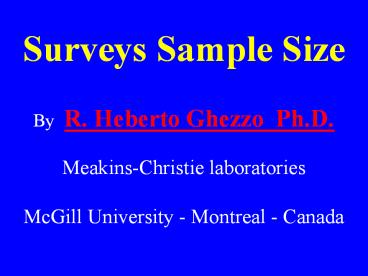Surveys Sample Size - PowerPoint PPT Presentation
Title:
Surveys Sample Size
Description:
Total Sample Size. If design is stratified and tests/estimations will be done at each strata. The sample size applies to each strata. ... – PowerPoint PPT presentation
Number of Views:145
Avg rating:3.0/5.0
Title: Surveys Sample Size
1
Surveys Sample Size
By R. Heberto Ghezzo Ph.D. Meakins-Christie
laboratories McGill University - Montreal -
Canada
2
Objective of the Study
Estimation
Prevalence
Odds- Ratio Relative Risk if Cohort
Comparison
Prevalence
Odds-ratios Relative Risk if Cohort
3
Estimation
- Confidence level
- 90 95 99 - Acceptable width of interval - 1 , 5
, 10 , 20
4
Comparison
- Error type 1 - alpha
- 0.05 0.01 - Smallest difference worth detecting - delta
- Error type 2 - beta
- 0.10 0.05 0.01
5
Error type 1 - alpha
Error in claiming a difference when there is none.
Alpha percent of normal people are thus
classified into abnormal
6
Error type 2 - beta
Error of not finding a difference when the
difference is greater than the threshold or value
of delta. Depends on the definition of the
threshold i.e. the difference worth detecting,
delta .
7
Which size?
In surveys the errors are generally the
same i.e. alpha beta The level depends on the
importance of the issue. Critical studies use
beta0.01
8
Estimation of a Prevalence
n z21-a/2 p(1 - p) / d2
n z21-a/2 (1 - p) / e2 p
a error type 1 - alpha
d absolute width of conf.interval
e relative width of conf.interval
9
Estimation of an Odds-Ratio
n z21-a/2 1/p1(1-p1) 1/p2(1-p2) / ln2(1-e)
a error type 1 - alpha
e relative width of conf.interval
p1 proportion exposed in cases
p2 proportion exposed in controls.
OR p1(1-p2)/(1-p1)p2
10
Estimation of a Relative Risk
n z21-a/2 (1-p1)/p1 (1-p2)/p2 / ln2(1-e)
a error type 1 - alpha
e relative width of conf.interval
p1 proportion exposed in cases
p2 proportion exposed in controls.
RR p1/p2
11
Comparing 2 prevalence
n z1-a/2 2p(1-p) z1-b
p1(1-p1)p2(1-p2)2/(p1-p2)2
If p lt 0.05
N (z1-a/2 z1-b)2 / 0.00061(arcsin
p2 - arcsin p1)2
b beta 1-Power
p (p1 p2)/2
12
Testing Odds Ratio gt 1.0
n z1-a/2 2p2(1-p2) z1-b
p1(1-p1)p2(1-p2)2/(p1-p2)2
p1 prevalence of exposure in cases
p2 prevalence of exposure in controls
b beta 1-Power
13
Total Sample Size
If design is stratified and tests/estimations
will be done at each strata. The sample size
applies to each strata.
Otherwise all within strata comparisons or
estimations will have larger errors or confidence
intervals.
14
True Size I
These formulae are theoretical. No real variable
is truly normal. The estimator of variability has
its own variability. There is no
guarantee that the precision postulated will
be achieved.
15
True Size II
The estimator of variability comes from a
different study. If the variability of the
proposed study is larger the precision will
deteriorate. Always use a beta error smaller
than really needed and adjust the sample size
upwards to a round number.
16
Non Response
The sample size refers to the number of complete
responses needed. Non response must be estimated
and taken into account to arrive to the final
size
17
Imputation
To impute is to fake a value that does not
exist
Only to complete observations for a multivariate
technique































